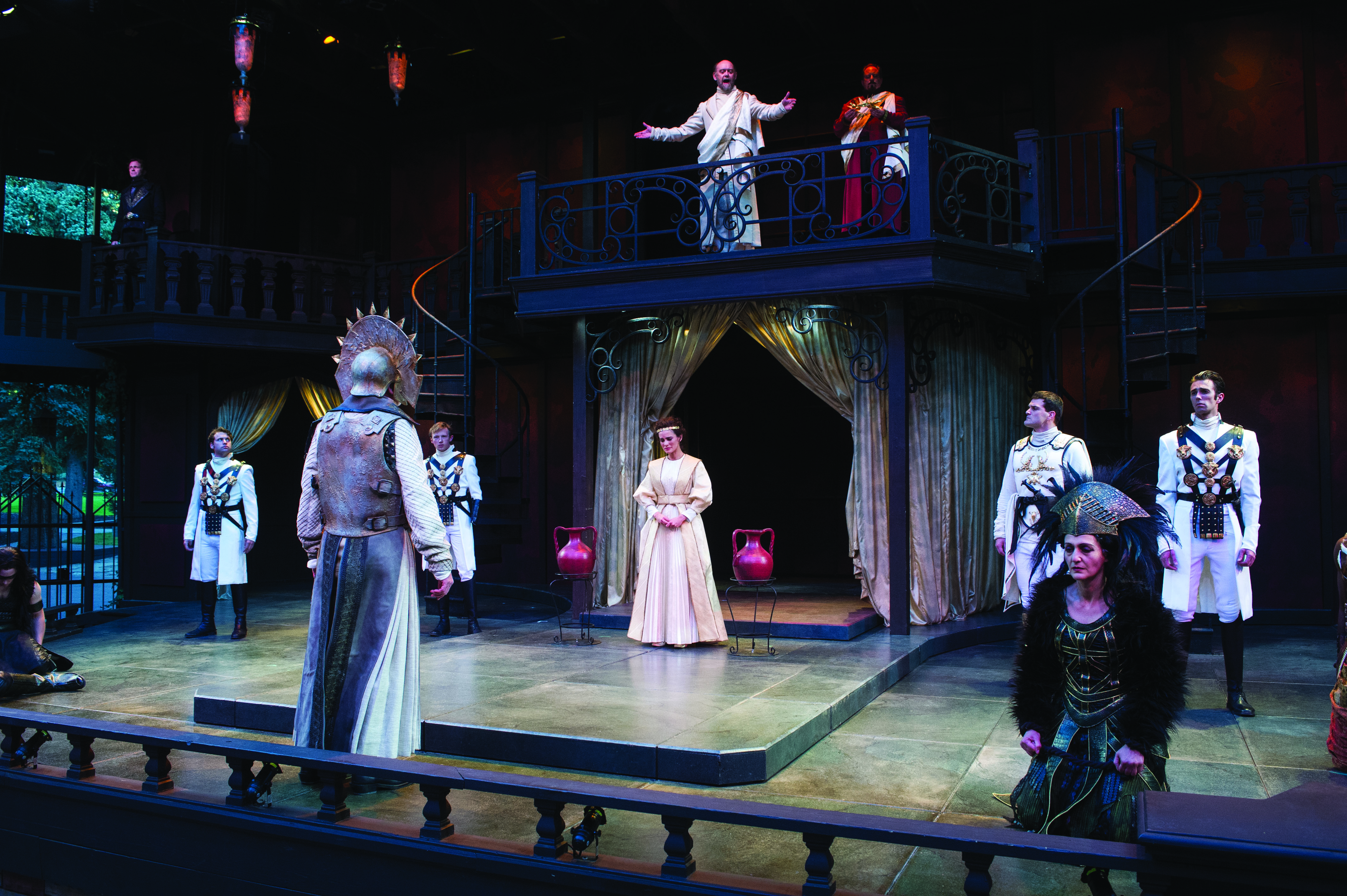CEDAR CITY — At the end of one moving scene in Titus Andronicus, Lavinia—the daughter of the title character—carries her father’s severed hand off stage in her teeth. This gruesome image is just one of many macabre moments that make Titus Andronicus a play that I will remember for a long time.

Titus Andronicus is the story of an elderly Roman general who returns from a victorious war with four prisoners: Tamora (Jacqueline Antaramian), the queen of the Goths, and her sons, Alarbus (Matt Holzfeind), Chiron (Jeb Burris), and Demetrius (Steve Wojtas). In a whirlwind of events, Alarbus is executed and Tamora marries the new Roman emperor, Saturninus (John G. Preston). Tamora and her sons decide to avenge Alarbus’s death by attacking Titus’s sons and his daughter, Lavinia (Melisa Pereyra). In payment for their deeds, Titus vows to strike back at Tamora’s family. Needless to say, with a story based on a vendetta and a counter-vendetta, Titus Andronicus is probably Shakespeare’s bloodiest play, and the body count at the end is quite impressive.
Directing Titus Andronicus must be quite a challenge. The opening scene of the play is complex; every major character is on stage at once with most of them having speeches and dialogue that deliver important exposition necessary to make the rest of the play comprehensible. In my opinion, Henry Woronicz’s direction was clear and helped guide me through the relationships and actions in this important opener. (However, I should note that my companion missed some of the political aspects of the scene, so perhaps my reading of the play earlier in the week prevented any confusion for me.) Woronicz was also effective in exploiting the blood imagery in the later scenes and create stage pictures that were extremely memorable, such as the image I mentioned at the beginning of the review.
Woronicz’s supreme directing was clear in the scene where Titus’s brother, Marcus Andronicus (A. Bryan Humphrey) discovers Lavinia after her attack. The scene has the potential to drag because Marcus has a long block of text to deliver without Lavinia making any reply. Woronicz effectively guided Humphrey to create a riveting scene that ensured I felt the maximum amount of sympathy possible for the wounded Lavinia. On the other hand, Woronicz changed some of the action in the latter half of the play to give Lavinia a larger role in exacting revenge against Tamora’s family. I’m not sure I agree with the choice, but I must admit it made the action more visually interesting. Plus, the change probably coincides more with modern views of women than does the action described in Shakespeare’s script.
Dan Kremer played the title character with a dignity that one would expect from a lifelong soldier and the commander of an army. I felt that Kremer’s focus on plotting revenge was appropriate for a character who had spent a career planning the suffering of others through battles and sieges. The best performance, though, in my opinion was from Peryera. As Lavinia, she sparkled in the opening scenes, displaying genuine affection for her husband, Bassianus (Chris Amos). This made her character’s fate much more tragic than it would have been otherwise. After the attack, I admired Peryera for her ability to communicate non-verbally. In several scenes she used gestures, moans, and body language to clearly show her character’s feelings and goals.
The rest of the cast was suitable for their roles. However, none of the performances were particularly memorable for me. This isn’t because the performances were deficient in any way. Rather, Titus Andronicus is lacking in character development. Few characters have any depth beyond their social position or the actions they must perform in order to move the story along.
I commend Donna Ruzika for her superb lighting design, which amplified the increasingly somber and tense mood of the story. Ruzika’s designs were especially effective in the final act when she bathed the stage and the actors in dark red lights to emphasize the bloody events of the end of the story. Kevin Copenhaver’s costumes were also interested and visually pleasing. Instead of dressing the cast in minutely researched and historically authentic Roman costumes, Copenhaver instead chose a stylized wardrobe with slight Roman influences for the actors. I thought that some of the costumes (such as for the Roman civilians) would fit in very well on the set of a science fiction film, which to me de-emphasized the Roman setting and focused attention on the broader themes of the story and perhaps made them more applicable to today.
One of the great pleasures of seeing Titus Andronicus, though, is knowing what would be in store in the future for the author’s career. Titus Andronicus contains motifs that would be later fully developed into major plot points in Othello, Hamlet, King Lear, and Macbeth—Shakespeare’s greatest tragedies. For example, in Titus Andronicus the feigned madness of the title character is short-lived and a relatively minor part of the story. Yet, it bears unmistakeable similarities to Hamlet’s madness. No, Titus Andronicus is not Shakespeare’s finest script, but it is an integral part of the Shakespearean canon, and I believe that my appreciation for his better known tragedies has increased after seeing Titus Andronicus.
Although Titus Andronicus lacks the brilliance of Shakespeare’s later work, I recommend that Utah audiences see this production of the play. Anyone who has read many of my reviews knows that I often urge people to see plays that are not produced frequently in this state, and Titus Andronicus certainly falls into that category. But this production has the added bonus of being beautifully designed, expertly directed, and performed in an Elizabethan-style theater. Titus Andronicus was quite popular during Shakespeare’s lifetime, and it’s a play that I believe deserves to regain some of the esteem that Renaissance audiences had for it.
[box type=”shadow”]The Utah Shakespeare Festival production of Titus Andronicus plays on select days at the Adams Shakespearean Theatre through September 1. Tickets are $22-71. For more information, visit www.bard.org.[/box]

